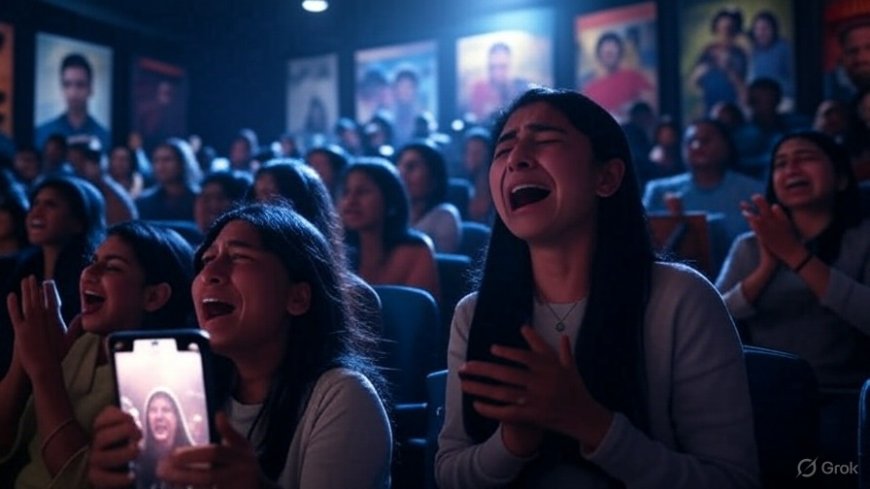Are Tears and Outbursts in Theatres Bollywood’s New Marketing Trick? The Rise of Audience-Driven Publicity
Is Bollywood exploiting emotional reactions like crying and shouting in cinemas as part of its marketing strategy? Explore how viral audience responses may now be influencing box office success.

Introduction: The Age of Emotion-Driven Publicity
In recent years, something peculiar has been happening inside Indian movie theatres. Viewers are no longer just silent spectators. Instead, they're seen crying uncontrollably, screaming, clapping, kneeling, and sometimes even fainting—all while the film plays on the screen. These intense reactions are captured and shared widely on social media platforms like Instagram Reels, YouTube Shorts, and X (formerly Twitter).
The virality of these raw, emotional videos raises a critical question: Is Bollywood subtly turning public emotion into a new-age marketing strategy?
The Emergence of Audience-Centric Marketing
Traditionally, Bollywood promotions involved posters, TV spots, trailers, and star-studded events. However, in the post-COVID landscape and the age of short-form content, the focus has shifted. Now, the audience itself is part of the campaign.
Here’s how it works:
-
Emotional videos of viewers breaking down or reacting strongly go viral.
-
These clips are picked up by news portals and influencers, gaining millions of views.
-
The emotional narrative becomes part of the film’s identity.
-
Viewers are subconsciously encouraged to experience rather than watch the film.
Examples That Sparked the Trend
1. The Kashmir Files (2022)
Directed by Vivek Agnihotri, The Kashmir Files was one of the earliest and most notable examples. The film triggered visceral reactions from audiences, with numerous videos surfacing showing people crying, shouting slogans, and visibly shaken after screenings.
Despite limited initial promotions, the film became a blockbuster, raking in over ₹340 crore globally, fueled in part by this emotional virality.
“The public made the film a movement,” said Agnihotri in a News18 interview.
2. Satyaprem Ki Katha (2023)
A romantic drama wasn’t expected to trigger such deep responses, but videos emerged showing female audiences in tears during the film’s climax. While the content was emotional, the question remains: were these reactions spontaneous, or subtly encouraged by the creators for publicity?
3. Laapataa Ladies (2024)
Despite being a small-budget film, this Kiran Rao-directed movie saw viral traction thanks to audience reaction videos. Clapping, cheers, and laughter became part of its identity on platforms like Instagram and Facebook.
Suddenly, small films were competing with mega blockbusters by leveraging genuine-seeming emotional audience marketing.
Behind the Curtains: Planned or Organic?
While some reactions may be genuine, many insiders suggest that PR agencies may now be orchestrating emotional responses. Here's how:
-
Influencers are planted in theatres to record themselves reacting emotionally.
-
Fan screenings are staged with controlled lighting and camera placement.
-
Hashtags like #MustWatchExperience or #CriedInTheatre are promoted in comment sections.
These techniques align with emotional contagion marketing, a psychological strategy that influences others to feel similar emotions through shared visuals.
Bollywood’s Shift to Experience Marketing
In an era where audiences are bombarded with entertainment options—from OTT platforms to international content—Bollywood is slowly transforming the cinema experience into something more intimate and immersive.
Instead of saying “Watch this film,” marketing teams now suggest, “Feel this film.” This is a strategic repositioning that aligns with global trends in immersive storytelling.
According to FICCI-EY’s Media & Entertainment Report, audience engagement is no longer passive—emotional connection drives retention and box office returns.
Social Proof and FOMO: A Powerful Combination
Emotional reactions in public settings create social proof—a psychological trigger that pushes undecided viewers to participate in the same experience.
When potential audiences see others crying, clapping, or overwhelmed, it generates FOMO (Fear of Missing Out). This emotional pull becomes stronger than traditional reviews or star power.
“If everyone’s crying in the theatre, I have to see what it’s about,” said one user in a viral X thread about Article 370.
Ethical Concerns: Is Manipulating Emotion Fair?
While this strategy is effective, it raises ethical red flags:
-
Is it manipulative to seed false audience reactions for marketing gains?
-
Are viewers being subtly pressured to feel something specific?
-
Is Bollywood trading authentic storytelling for emotional spectacle?
Filmmakers and critics are divided. While some call it “creative PR,” others believe it undermines genuine cinematic appreciation.
Audience Reaction Marketing: Here to Stay?
Given the high ROI and viral potential, this marketing technique isn’t going away anytime soon. However, its success hinges on audience trust. If viewers begin to sense that their emotions are being staged or exploited, it could backfire and damage a film’s reputation.
For example, Adipurush (2023) faced massive backlash despite initial positive crowd reaction videos, when viewers realized they had been misled by early hype.
Conclusion: A Double-Edged Sword
The practice of showcasing emotional audience responses as a marketing tactic is undoubtedly effective, but it toes a fine line between authentic connection and performative manipulation.
Bollywood must tread carefully. Emotional storytelling has always been its strength, but exploiting that emotion as a publicity gimmick could lead to distrust and disappointment.
Whether this becomes a sustainable model depends on how responsibly filmmakers and PR teams wield it.
Key Takeaways
-
Emotional audience reaction videos are becoming a core marketing tool in Bollywood.
-
Films like The Kashmir Files and Laapataa Ladies used such strategies to go viral.
-
These reactions can be both genuine and PR-managed, blurring ethical lines.
-
The tactic leverages emotional contagion and FOMO to boost ticket sales.
-
Long-term trust in cinema depends on balancing authenticity with strategy.




















































